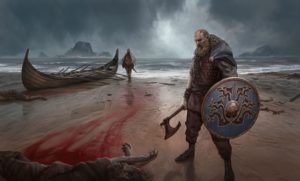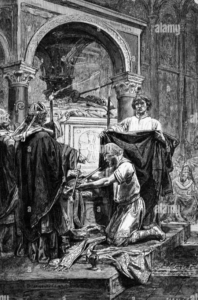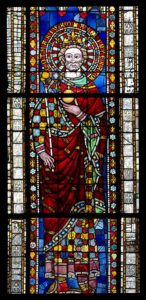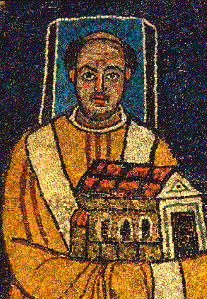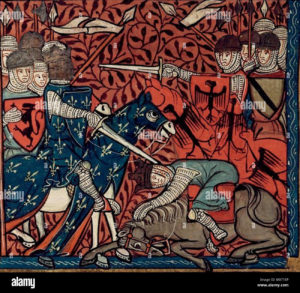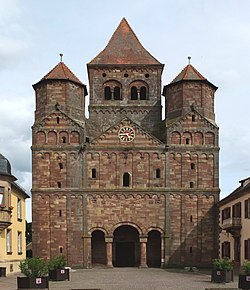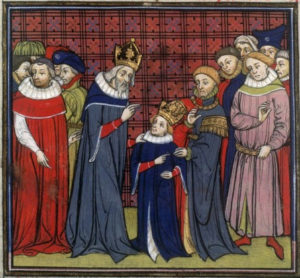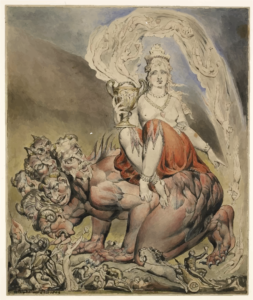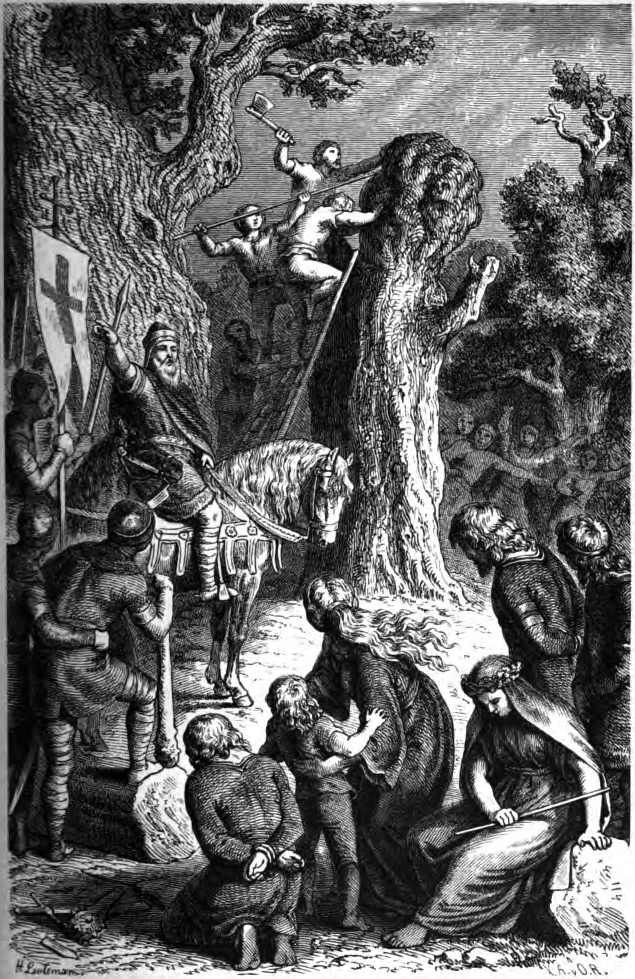– For the context of these translations click here –
The Slavic worm and the Frankish people of God
The 46 years of Charlemagne’s reign were an almost uninterrupted war with nearly fifty military campaigns. To mention only the Saxons, the ‘super-pagans’, he fought them mortally for thirty-three years! So what was happening on the periphery of the great and ever-expanding predatory empire was not something that affected the internal ‘peace.’ Quite the contrary. The more ‘peace and order’ there was within, the better the slaughter, enslavement and annexations outside the borders worked. However, the ‘everywhere abundance and joy’ didn’t exist even in the interior of the kingdom. It was enjoyed only by the ridiculously small stratum of the possessors, the nobility and the clergy, who swam in the blood-soaked riches of others, while chronic malnutrition ravaged the ignominiously deprived people themselves. Misery and famine wiped out a third of the population of Gaul and Germania in 784.
Under Charlemagne’s grandsons, foreign war was simply replaced by internal war, by the so-called civil war.
Perhaps the Treaty of Verdun wasn’t yet, as some early historians (Waitz, Droysen, Giesebrecht) believed, a kind of ‘birth date’ of the German and French nationalities, of two peoples in whose interests it was certainly not agreed. But a German history and a French history are emerging: nations are beginning to emerge from older tribes, from the populations of certain countries, and the pre-national consciousness of the tribes will eventually become the national consciousness.
In addition, the emergence of other national kingdoms, for example in England, Spain, Scandinavia, Poland, Bohemia and Hungary, marked the early Middle Ages politically. Certainly, throughout the whole of the 9th century, there was still no thought of nationalist categories, no people still felt themselves to be a ‘national unit’ and no one felt themselves to be ‘German’ or ‘French’; perhaps not even in the 10th century, although this was the immediate transitional phase.
That division of the Carolingian empire, which was followed by further divisions and reunifications in the 9th century, was a compromise imposed by circumstances. For the time being, it certainly put an end to the tradition of rushing against each other; but it also meant that the empire gradually lost its pre-eminent position vis-à-vis the papacy, that the triple division of Germany, France and Italy was prepared, and that the old unity never reappeared, if we leave aside the episode of Charles the Fat.
The Slavs were pagans, and even in Christian countries such as Thuringia, Hessen and the East-Franconian cantons they remained ‘infidels’ for longer than the rest of the population. Their culture was demonstrably higher than is sometimes assumed. We must bear in mind that for a long time, from the 7th to the 11th century, Franco-German accounts of the Slavs came almost without exception from Christian priests, who moreover were often not eyewitnesses but had second- or third-hand accounts. And, as was almost always the case, the Christians were at war with the Slavs and mocked them. But when they were regarded as allies, they were suddenly well-liked and sometimes even remarked that they were ‘wonderfully worthy’ of any sympathy.
The Carolingian and Ottonian historiographies also differ in their judgement, although a certain popular hatred, if not hereditary hostility, has long prevailed, due in large part to religious motives, to the opposition of pagans and Christians. This had been the case since Merovingian times. Later, the Slavs were willingly condemned across the board. The more Christian the world becomes, the worse the others become. They are all ‘evil’, i.e. people separated from God; they are all ‘infidels’, which in the medieval view derived from Augustine is equivalent to ‘minions of the devil, who must be annihilated by all means if they do not convert to the cause of God’ (Lubenow).
In the eyes of the Christians, the Slavs were useful only as slaves: a word derived directly from slavus or as pure targets of death; people who were mocked as ‘worms’ and ‘mowed down like the grass of the meadow’ by pious Catholics, for whom they were just that, subhuman beings, animals. ‘What do you want with those toads? Seven, eight, even nine of them I used to skewer on my spear and shake them around, muttering something to myself.’ The Slavs were also radically false and treacherous. ‘The Wendos broke their word in their usual disloyalty to Louis’, comments not only the Annales Bertiniani.
According to the ecclesiastical conception, every Christian prince had to fight the pagans within the country and on the borders. Indeed, according to the dominant Augustinian doctrine concerning the expansion of the kingdom of God on earth, it was necessary to conquer the Slavic East to ‘convert’ it. It is no coincidence that Charlemagne’s favourite reading was Augustine’s magnum opus, The City of God. And Charles himself, the Carolingians, the Frankish aristocracy at one with the other classes of landowners, all without exception, were all the more interested in the ‘plunder’, robbery and tribute of the East when in their own country the agricultural productivity was low and the prospects of increasing land and estates insignificant. The Slavic territories were also always a breeding ground for auxiliary troops and slaves.
The Christian nobility didn’t always view the Slavic mission with unreserved joy; and naturally for a very selfish reason. With the acceptance of Christianity by the pagans, at least as far as the Saxon noble class bordering directly on Christian territories was concerned, a pretext for attack, subjugation and plunder disappeared. ‘Although the Christianisation of the Slavs didn’t entail the complete depletion of an important source of income, it certainly at least made it more difficult for the Saxons to plunder their neighbours’ (Donnert). And of course for the Christians their bloodletting was always more important than the gospel; the Catholic princes were concerned above all with power, greed, the increase of their agrarian possessions and feudal rents, for as Abbot Reginus said ‘the hearts of kings are greedy and always insatiable.’ Archbishop William of Mainz said that the claim of his father Otto ‘the Great,’ that it was about the spread of Christianity, was an excuse. And in the Slavonic chronicle of Helmhold, referring to Henry the Lion, it is later stated in no uncertain terms: ‘There was never any talk of Christianity, but only of money.’
The Temple of a Slavic god (painting in oil by V. Ivanov).
But it is not simply ‘that Christianity first gained a foothold beyond the Elbe and the Saale in connection with the war’ (Fleckenstein). No, the Christian Church, and of course, the German Church, was also a ‘driving force’ in this highly aggressive eastward expansion: a force for which faith was also a means to an end; a force, writes Kosminski, that
was on the hunt for tithes, goods and personal services and saw the conversion of the heathen as a highly profitable business. It was most energetically aided in this by the papacy, which was one of the main organisers of the military campaigns against Eastern Europe, hoping to extend its sphere of influence and increase its income.
An independent ecclesiastical mission, such as that of Bishop Ansgar, bought boys in Denmark and Sweden to make clerics of them: the mission of Bishop Adalbert of Prague at the end of the 10th century or that of Günther of Magdeburg among the Luthites at the beginning of the 11th century. As these attempts at conversion met with little success, the Church opted for a second way: spreading the Good News through state armies, by blood and fire or by bribery. In any case, acceptance of Christianity was for the Slavs ‘tantamount to slavery’ (Herrmann), and acceptance would be all the easier the more effective weapons could demonstrate the power of the God of the Christians and the impotence of the old gods.

